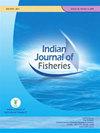Effects of environmental factors on the spatio-temporal patterns of bigeyes (Priacanthus spp.) in the northern South China Sea
IF 0.3
4区 农林科学
Q4 FISHERIES
引用次数: 0
Abstract
Bigeyes (Priacanthus spp.; Family: Priacanthidae) are among the most significant demersal fishes in northern South China Sea (nSCS). Based on the bottom trawl data of nSCS from 2009 to 2014, this study applied the SARIMA (Seasonal Autoregressive Integrated Moving Average) model and the centre of gravity movement to analyse the spatio-temporal patterns of catch per unit effort (CPUE). Combining with the corresponding environmental factors of each trawling cruise, including bottom water temperature (BWT), bottom water salinity (BWS) and sea surface height (SSH) and their relationships with the CPUE were analysed by generalised linear model (GLM). The results indicated that, the monthly CPUE varied in half a year as a period and the peak in the first half year was obviously lower than the one in the second half year. The annual temporal trend of the centre of gravity movement was similar, which was related to the monthly variation of CPUE. Among the environmental factors, SSH had the greatest impact on CPUE, especially in October, November and December, 2009 and 2012; BWS had a significant impact on CPUE in July, August and September, 2009 and October, November and December, 2012. The spatio-temporal scale of the CPUE was mainly influenced by SSH and BWS under the effect of nSCS currents. This study presents a method for spatio-temporal variation of economic fish CPUE, integrating the centre of gravity movement and the temporal variation of the CPUE with the environmental factors, which is helpful for determining the fishery management unit and closed fishing season in the nSCS. Keywords: Bigeye fish (Priacanthus spp.), Environmental factors, Generalised linear model (GLM), Northern South China Sea (nSCS), Spatio-temporal patterns环境因子对南海北部大眼鱼时空格局的影响
大眼睛目;棘鱼科(Priacanthidae)是中国南海北部最重要的底栖鱼类之一。基于2009 - 2014年nSCS底拖网数据,应用SARIMA(季节性自回归综合移动平均)模型和重心运动分析了单位努力渔获量(CPUE)的时空格局。结合各拖网巡航相应的环境因子,包括底水温(BWT)、底水盐度(BWS)和海面高度(SSH),利用广义线性模型(GLM)分析了它们与CPUE的关系。结果表明,月均CPUE以半年为一个时间段,且上半年的峰值明显低于下半年。重心运动的年际变化趋势相似,这与CPUE的月变化有关。在环境因子中,SSH对CPUE的影响最大,特别是在2009年和2012年的10月、11月和12月;BWS在2009年7月、8月、9月和2012年10月、11月、12月对CPUE有显著影响。在nSCS流的作用下,CPUE的时空尺度主要受海冷和BWS的影响。本研究提出了一种将经济鱼类CPUE的重心运动和时间变化与环境因素相结合的时空变化方法,有助于确定nSCS的渔业管理单位和休渔期。关键词:大眼鱼,环境因子,广义线性模型,南海北部,时空格局
本文章由计算机程序翻译,如有差异,请以英文原文为准。
求助全文
约1分钟内获得全文
求助全文
来源期刊

Indian Journal of Fisheries
FISHERIES-
CiteScore
0.90
自引率
20.00%
发文量
0
审稿时长
6-12 weeks
期刊介绍:
Indian Journal of Fisheries is published quarterly by the Indian Council of Agricultural Research (ICAR), New Delhi. Original contributions in the field of Fish and fisheries science are considered for publication in the Journal. The material submitted must be unpublished and not under consideration for publication elsewhere.
Papers based on research which kills or damages any species, regarded as thratened/ endangered by IUCN crieteria or is as such listed in the Red Data Book appropriate to the geographic area concerned, will not be accepted by the Journal, unless the work has clear conservation objectives.
 求助内容:
求助内容: 应助结果提醒方式:
应助结果提醒方式:


